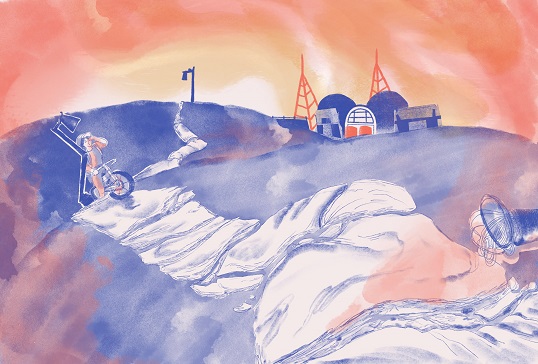It all began in 2012, when I had the idea of translating classic Japanese works into modern spoken Japanese for students to understand and enjoy more easily. To begin with, I selected The Narrow Road to the Deep North by Matsuo Bashō.
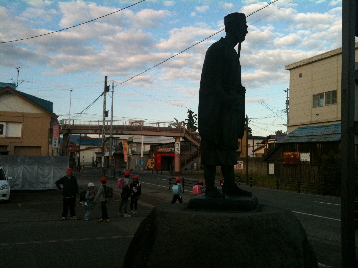
Photograph by Durian Sukegawa
I finished the work of translating in a month but could not shake the feeling that I was not being true to myself. It was as if Bashō himself were whispering in my ear, “Since when did you forget who you are? You, who went to Eastern Europe to report on the revolutions of 1989 . . . You, who went to Cambodia for the dispatch of Japanese peacekeeping forces . . . And what are you doing now?”
Traveling North by Bicycle
Three hundred and thirty years ago, in 1689, Matsuo Bashō and his disciple Kawai Sora set out on an ambitious journey to travel through the old province of Michinoku in northern Japan. Starting from Fukagawa in Tokyo, they headed north through what are now the prefectures of Saitama, Tochigi, Fukushima, Miyagi, and Iwate. From there, they went inland from the Pacific coast, through the mountainous terrain of Yamagata Prefecture, over to the Japan Sea coast, and as far north as the town of Kisakata in Akita Prefecture. Turning south through the Shonai region, they followed the Japan Sea coastline, travelling through Niigata, Toyama, Ishikawa, and Fukui Prefectures, before heading inland through Shiga to finish up in Gifu. It was an epic journey.
In 2012, it had struck me that Bashō’s original route traversed areas that were now confronting the major issues of the time in Japan, namely the aftermath of the March 2011 earthquake, tsunami, and nuclear disasters, along with the depopulation of rural regions. It seemed only right that I too should travel that same route, to see with my own eyes and explore for myself the state of post-2011 Japan, in places where the media did not reach.
I knew if I walked there was no knowing when I would finish, so I decided to cycle instead. After buying a fold-up bicycle, I put a dosimeter in my rucksack and prepared to set off. It was scorching hot when I departed in mid-August of 2012, the year after the earthquake. The plan was to spend a week or so at a time sweating it out on the road before packing up my bicycle and catching a train back to Tokyo. The following month, I would return by train to continue my journey from where I had left off.
In the end, it took about four weeks in total to trace almost the entire length of Bashō’s route. By the time I pushed my bicycle to the finish in Ogaki City, after one of the tires got punctured on the very last leg, it was mid-November.
I had some unforgettable conversations with people I met along the way who spoke to me from the heart. So many had had their livelihoods destroyed following the contamination of their land by radioactive fallout, but since they had neither evacuated nor lived in temporary housing compounds their voices were rarely heard in the media. As a writer, their experiences lit a flame in me to share their stories. At the same time, however, I was deeply conflicted about going public with the record of my journey because of the possible consequences for them, and for a time I resolved never to publish it.
It would take until 2018 for me to finally do so, but in the end, I did release a full account in my book Senryokei to oku no hosomichi (A Dosimeter and the Narrow Road to the Deep North, 2018). This is a record of what I saw and the people I met, as well as a document of the radiation levels I measured in each place I visited. I also described my journey in a spoken word performance, set to music and against a projection of images that I had photographed along the way.
What follows is a selection of just some of the encounters and sights from that journey that left a deep impression on me.
Decontamination
At Nasu in northern Tochigi Prefecture, I met a farming couple at their wits’ end. They were Wagyu beef cattle breeders who practiced a sustainable style of farming called circular agriculture, using organic fertilizer to grow feed, vegetables, and rice. But that was all made impossible by the nuclear accident at Fukushima Daiichi.
Initially, they told me, nobody had informed the residents of Nasu that high-level radioactive substances had fallen over northern Tochigi. And so, day after day, this couple had endured growing anxiety as they watched trains carrying evacuees from Fukushima pass through Nasu, wondering all the while if their land was all right.
A visiting vet had eventually given them the news that the dosimeter needle was off the scale, but by then it was too late. Their cows had already eaten highly contaminated straw and grass and could not be shipped to market. The couple decided to stop breeding cattle. Workers dressed in protective gear came to scrape away the topsoil and fertilizer from their land, piling it up in a corner of their farm. Though this scraped earth measured over 100,000 becquerels, the workers had merely covered it over and left it there. Removing it from the property was not permitted. Yet this is what the authorities labelled “decontamination completed.”
The road to receiving compensation was long, and farmers in Nasu were becoming worn out, the husband told me. “At this rate people will start to take their own lives,” he said. A calf had just been born in their barn. Though the farm was no longer in the business of breeding cattle, they still had to take care of their animals. “Ah,” he said to me, repeatedly, “if only we could turn the clock back to before March 11.”
Is it Right to Make Radiation Levels Public?
Not far from Nasu, in the village of Nishigo, just over the border in Fukushima Prefecture, I visited a welfare facility run by a Christian organization. Here they cared for children with intellectual disabilities, providing them with a home and refuge from neglect or abuse. Many, apparently, had only learned after coming to live there that birthdays were something to celebrate. Staff had done their best to give these children as normal a life as possible, but then the nuclear accident occurred.
Although the grounds had been decontaminated, a monitoring post next to the road showed a reading of 0.59 microsieverts per hour. The director, also a priest, said to me, “Before answering questions about the long-term effects of radioactive contamination on the human body, we should think about what a blatant violation of basic human rights this is.”
The entire village of Nishigo had been exposed to high levels of radiation. Now, even during summer, the children must wear long sleeves and keep the windows shut at all times. They cannot play outside. They cannot go wherever they like. They cannot eat whatever they want. If that is not a loss of basic human rights, what is?
Even at this children’s home, the topsoil that had been scraped away for decontamination had simply been left heaped in a corner, covered with blue plastic sheeting. Removing it was not permitted. Immediately next to the pile, there was a play gym in the shape of an airplane. When I got my dosimeter out the reading showed 1.62 microsieverts. This is high. Just as high as areas where mandatory evacuation had been enforced, yet here the children could reach out and touch the soil.
“It’s true the numbers are appalling,” the director said to me emphatically, “And it’s easy to say why don’t we leave, but where can we go with the children? We have nowhere else to live but here.”
He was right. Most people living in contaminated areas don’t have the choice to move.
It was during this conversation that I first began to have doubts about my journey. I had initially set out believing that taking radiation readings and listening to people talk about their troubles was a fair and reasonable thing to do. But was it fair? Was it right to make my readings public, knowing how much people, who had no choice but to live there, were suffering? It was a dilemma that weighed heavily on me for the rest of the journey.
No Need to Come Back
In the city of Fukushima every measurement I took was high. At Mount Shinobu (275m), in the center of the city, the level of radiation was 1.34 microsieverts. Meanwhile, in a high school at its base, students ran around energetically on the grounds. As I watched them breathe in the dust they kicked up, I was beside myself with worry. Would they be all right?
On the temple grounds near the Mochizuri Kannon, a statue that Bashō had visited, the reading was 1.48 microsieverts. This was a residential area, where people continued to go about their lives as usual. I noticed a rotting pile of agricultural produce in the neighborhood, likely picked from fields and gardens but not fit for consumption or sale.
Stunned by these readings, I spent the night at the home of W-san in Fukushima City. W worked as a tutor at a cram school and aspired as much as possible to follow a self-sufficient lifestyle. He rented fields abandoned due to depopulation, reclaiming the land and growing vegetables. He also fished for Japanese char and gathered mushrooms, wild edible plants, and nuts in the beech forests of the Ou Mountains. He took his inspiration for coexisting with nature from the hunter-gatherer lifestyle practiced in the prehistorical Jomon period.
But then his fields became contaminated by radiation and he was unable to grow anything anymore. Nor could he take fish from the rivers, as they exceeded the set standard of 100 becquerels. W-san had lost the foundations of his life.
“But I’m still part of the natural world,” he told me, “So my feeling is I would be a self-centered modern man if I threw it all away and went somewhere else simply because I didn’t feel comfortable here anymore.”
He told me this while we talked over drinks and pan-fried dumplings, a specialty of Fukushima. Then W turned to his high school-aged daughter sitting next to him and said, “Leave Fukushima when you go to university. No need to come back.”
She said nothing in reply. But her silence resounded in my ears like wordless sorrow.
Questioning My Journey Under a Blazing Sun
From Fukushima City I headed along Route 4 for the border with Miyagi Prefecture. It was tough going. The road stretched on and on uphill. No matter how far I pedaled, the hills kept rising up before me.
I saw women selling peaches and nashi pears at roadside stalls. The sun was beating down and it was blazing hot. Heat rose off the bitumen, and despite their umbrella shelters, it must have exhausted them.
Farmers in Fukushima had been wrestling with the issue of decontamination ever since the nuclear disaster. They had replaced soil and stripped bark from fruit trees in an effort to somehow grow peaches and nashi fit for consumption. At last, their efforts had been rewarded with a harvest of fruit that complied with food standards. But sales stalled. Consumer sentiment had become such that the word “Fukushima” was enough to turn buyers off. How did those women feel, I wondered, as they sat there at the side of the road, trying to sell their fruit?
It was then that it began to occur to me that anyone desperately trying to get back on their feet might not welcome any mention of radiation. Though it was impossible to ignore the fact that a large part of Fukushima Prefecture had been contaminated, I speculated that growers making a living from agriculture might prefer the topic not be brought up.
And so, I began asking myself what, exactly, was I trying to achieve on this journey? Should I perhaps limit myself to my personal goals?
The Street Portrait Artist and Entertainer
I continued on my way to Miyagi Prefecture, riding through the cities of Sendai, Tagajo, Shiogama, and Higashi Matsushima, where I saw the ravages of the tsunami still in evidence. Then I proceeded on to Ishinomaki. Though a year and a half had passed since the tsunami, the city was still half in ruins.
In Ishinomaki I met two people whose stories left a deep impression on me. One, a street portrait artist, told me how he and his family had waited for rescue on the roof of their house for two days until the tsunami receded. Though they had survived, the town had been decimated and the artist had lost all his tools of trade. He and his family had then embarked on an all-consuming struggle for survival. Fellow street performers sent him art materials and, six months after the tsunami, he was able to start work again.
Things had changed, though. He began to get customers who had lost loved ones. One day a bereaved mother whose child had been about to start school when the tsunami struck, came in with a photograph. She wanted to see the progress of her child’s growth, even if only in a drawing. The mother cried as she waited for the picture to be completed and the artist wept as he painted it.
Similar requests kept coming, and the artist became more and more distressed. Sometimes, when he was alone, he would cry out and weep. After overhearing him one day, his wife said something that changed him. “It’s honoring the dead,” she said. That simple observation led him to find it in himself to continue his work in the disaster-stricken town.
The other person I met in Ishinomaki was a street entertainer who played the organ. This musician, who suffered from panic disorder, had only just lost his beloved mother two months before the tsunami. On the day of the disaster he had loaded his organ into the car and taken refuge on the banks of the Kitagami River, where he had remained for four days with nothing to eat. When I met him, he was living in temporary housing and playing his organ in a corner of a Michi-no-eki roadside rest station. A restaurant at the Michi-no-eki gave him lunch, but otherwise he relied on gratuities from his busking to survive. Other victims of the disaster started stopping by to request songs from him. One day, as he was playing Furusato (or “Hometown”) as requested, a woman began to cry. Unable to stop, her tears eventually turned into loud wails. This incident left him with a painful sense of the wounds and depth of sorrow the disaster had left in people’s hearts.
The Burned-Out School
The most heartrending sight of all in Ishinomaki, however, was the children I saw playing baseball in an abandoned, burned-out school. The school had been left untouched since it was engulfed by the tsunami and then caught fire from the gasoline leaked from cars overturned by the waves. Watching children in matching baseball uniforms chase a ball around the yard of the ruined school, my eyes filled with tears.
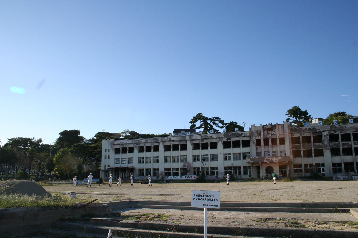
Photograph by Durian Sukegawa
How could this be? I knew what the media had been reporting. Enormous sums of money had been donated not just from all over Japan, but all around the world. And yet, from those funds intended for disaster relief and recovery, 4.2 billion yen (approximately US$38 million) had been quickly earmarked for the Monju fast-breeder reactor project. Why? When none of that money had made its way here to be used for reconstruction? Why was this primary school still neglected after a year and a half? Of course, not everything can be done at once. But what could possibly explain why a nonoperational, problem-plagued fast-breeder nuclear reactor should be given priority over these children? What legacy were we leaving them? I gnashed my teeth in anger.
The next day, riding in the rain, I was suddenly overcome by everything. Maybe it was exhaustion, or the shock of seeing those children in the burned-out school, but as heavy drops of rain beat down on me, I felt in imminent danger of falling apart. What did I think I could achieve with this journey? I was in no doubt that anyone living in a contaminated area, with no choice but to stay put, wanted only to forget all about radiation.
By now I was in the town of Hiraizumi, where I toured the halls and pagodas of Chusonji Temple in the pouring rain. I was soaked to the skin and decided that enough was enough. I would go back to Tokyo. Then, just at that moment, I realized I was standing at the bottom of the hill where Gikeido, the memorial to the warrior Yoshitsune Minamoto, was located. This was the site of the tower house in which he reputedly took his own life. Soaking wet, I began to climb the long flight of steps. As I did, by some strange coincidence the rain stopped, and abruptly the sun’s rays broke through. When I reached the top of the stairs I looked up.
There, before me, was the last scene that Yoshitsune would have laid eyes on and, now, above it, I saw a gigantic rainbow.
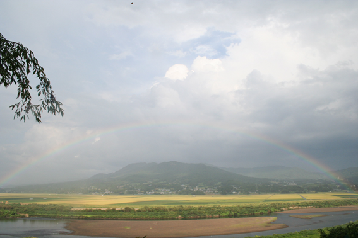
Photograph by Durian Sukegawa
“Don’t give up,” I thought I heard Bashō whisper.
What Happened After
My journey along the narrow road to the deep north continued. Then, year after year, I went back to Fukushima and Tochigi, to see again the people I had met and to check on changes to the radiation levels.
The Wagyu cattle breeders in Nasu obtained a license to grow hemp for fiber and their farm was getting back on its feet. They replaced all the soil in their fields and were growing vegetables and rice with no detectable radiation. I returned for a spoken word performance at a temple on their farm, and also arranged for the actor Atsuo Nakamura to perform his dramatic monologue, Senryokei ga naru (The Dosimeter Buzzes), there.
Nevertheless, grassy areas and pastures that had not been decontaminated continued to give high readings. And the straw and compost that had been removed remained in a corner of the farm. The husband now says he has hardly any memory of the time around the nuclear accident, which is probably a measure of just how much strain he had been under then.
At Nishigo, the entire grounds of the children’s home had been decontaminated and the pile of contaminated soil I had seen previously had been removed to a temporary storage site in the village. However, levels had risen again apparently in the sections of the yard that were decontaminated first. This is a sign of cesium coming down from the mountains.
The director told me that the children chose not to go outside to play anymore. He also said that the number of young women working at the facility was noticeably decreasing. What do such changes bode, I wonder, for the future of Fukushima Prefecture?
W-san, with whom I drank and ate dumplings in Fukushima City, had replaced the soil in his fields and was in the process of beginning to enjoy growing crops again. But he could not say that the mountains and streams had recovered. Radiation levels in mushrooms and edible wild plants were still high, and a ban on river fishing was still in place.
“I want people to distinguish between the actual damage, and the damage to reputation and the economy that fear of radiation causes,” he said. He worried that remaining tight-lipped to avert reputational damage would instead lead to people’s awareness of the actual damage and loss sustained from the nuclear accident fading from their memories.
Incidentally, W’s daughter did leave to go to university in Tokyo, but she returned to Fukushima to work after graduating and now lives with her parents again.
Can the Forests be Decontaminated?
As I continued to take measurements, year after year, I saw radiation levels gradually fall in urban and other areas. But there were also places where I observed the opposite.
The Yugyo willow tree in the fields around the hot spring village of Ashino in northern Tochigi, is one example. In 2012, my reading there was 0.19 microsieverts. But, by 2016, it had nearly doubled to 0.36 microsieverts.
Why would this happen? The answer was very simple. After radioactive material fell on the mountains it dissolved in the rainwater that was then absorbed by leaves that later fell and eventually, over time, came down from the mountains.
This is very serious, I believe, because 55 percent of Tochigi Prefecture and more than 70 percent of Fukushima Prefecture is forested. A decontamination process that simply scrapes away topsoil cannot be carried out in the forests and mountains. And even if urban areas are thoroughly decontaminated, there still remains plenty of radioactive material in the forests that will continue to descend into the cities slowly, by degrees. A process that will continue for a long, long time to come.
There was one place, however, where I observed the decontamination of a forest. In 2016, when I returned to Mount Shinobu in Fukushima City, I discovered that the peak had been rendered bald, and saw row upon row of flexible bulk container bags filled with contaminated soil. A nearby sign indicating this to be a temporary storage site, included the following statement: “Everything here is covered with green ultraviolet protective sheeting out of consideration for the scenery on Mount Shinobu.”
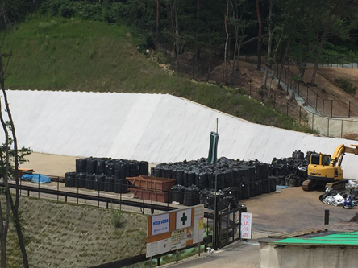
Photograph by Durian Sukegawa
What, in heaven’s name, could the person who wrote this be thinking? After felling trees on a mountain revered since the time of Bashō, after stripping away the earth and cramming tons of soil into containers instead, exactly how do they expect the phrase “out of consideration for the scenery” to be received?
Then again, there are some who would say that such decontamination is the only choice. My own view is that it doesn’t matter how much is done, the problem is still a long way from being solved. So far, there is no solution to the problem of a final storage site for radioactive materials in all of Japan. The temporary sites will be there forever, either overflowing with container bags of contaminated materials, or buried in the ground to remain there always. When I went to see the land along the coast in Fukushima Prefecture, including areas that had been evacuated, I discovered the whole coastline to be buried under black bags. These will only continue to mushroom in the future.
To the Fukushima Daiichi Plant
And so, at last I came to the Fukushima Daiichi Nuclear Power Plant.
I had begun thinking about the post-Fukushima situation while pedaling along in Bashō’s footsteps on the narrow road to the deep north in 2012, and my thoughts continued to take shape in the intervening years as I returned to take measurements at fixed points. Now, I had finally come full circle to the source itself, the site of the meltdown of three nuclear reactors.
Unlike my earlier solitary travels, I went in a group, The Japan P.E.N. Club Environmental Committee, to which I belong and which concerns itself with nuclear and marine pollution issues. After repeated applications we eventually received permission from the Tokyo Electric Power Company (TEPCO) to tour the grounds of the plant. Led by club chairman Shinobu Yoshioka, twenty of us headed for Fukushima Prefecture.
At TEPCO’s request, we paid a visit to their Decommissioning Resource Center in the town of Tomioka first, which itself had been an evacuation zone all these years. There, we heard a detailed explanation of the events of 2011. This included footage of the tsunami hitting the plant, and a reactor building being blown away by a hydrogen explosion. There was an equally detailed digital display to explain the current state of decommissioning, how many fuel rods remained in each of the reactors, and the status of melted fuel debris in each. TEPCO were apparently concerned with ensuring we had a basic knowledge of nuclear reactors and decommissioning before seeing the plant itself.
We left the resource center on a bus provided by TEPCO and headed for the plant at last. Despite the lifting of compulsory evacuation restrictions in the area, the scene that stretched along Route 6 from Tomioka to Okuma appeared unchanged from the day of the disaster. Seeing the houses with collapsed roofs and abandoned shops with broken windows, I wondered about the former residents, some of whom must have had favorable feelings toward nuclear reactors before this accident. A sign for a ruined sushi train restaurant called Atom stood as a melancholy reminder of life before disaster had struck.
The Basis for a Decommissioning Period of Thirty to Forty Years
Before entering the grounds of the Fukushima Daiichi Nuclear Power Plant, we underwent a security inspection every bit as stringent as at an airport. Though we weren’t required to wear protective clothing, it was a condition of our visit that we not hold anything in our hands and were prohibited from taking photographs. Our tour of the site took a predetermined course in the TEPCO bus, accompanied by a company employee as our guide. We were not permitted to get out to walk.
The guide gave us a running read-out of the radiation levels we were being exposed to. The average level in the grounds was around 40 microsieverts per hour. But, for a moment, when we came right alongside the No. 3 reactor, where a hydrogen explosion had taken place, we were exposed to even more intense radiation. The guide reported 280 microsieverts, but the dosimeter we had with us read 400 microsieverts. In any case, it was so outrageously high we obviously could not linger there.
As we gazed at the scene around us—the giant tanks where contaminated water was stored, the wrecked reactor shell, apparatus to absorb cesium, and endless rows of containers for storing radioactive waste—my colleagues commented on how frightening it was that even at that level of exposure we didn’t feel a thing.
When the tour ended, we returned to the resource center for a question and answer session with our guide. There, I was finally able to ask the question that had been bothering me for a long time.
“We are told that it will take thirty to forty years to complete decommissioning reactors number one, two, and three, which still have fuel rods and debris in them. What do you base those calculations on?”
The guide looked thoughtful for a moment and then calmly replied, “We are using the Three Mile Island accident for reference. It took ten years to decommission one reactor there. So, because we have three, we calculate thirty to forty years.”
My immediate reaction was to wonder if such a simple comparison could be valid. While it was true that a meltdown also occurred at Three Mile Island, the circumstances were different and the reactor there did not spew radioactive material. Here, TEPCO was still struggling to confirm the location of all the debris and did not even know yet how to extract it all.
“Surely that can’t be the basis?” I asked again.
The company guide nodded. “Well, if you say it’s no basis, I guess I’d have to agree. It might take a hundred years, or progress in technology could make it a lot quicker,” he said.
Currently, the cost of decommissioning stands at 200 billion yen (approximately US$1.8 billion) a year. That’s eight trillion yen over forty years—a burden that the Japanese people will ultimately have to shoulder—yet I had just heard an admission that it was a calculation with no proper basis. That sum could very well balloon even more.
“That’s why,” the guide continued, “we have to get the Kashiwazaki-Kariwa plant restarted. If we can do that then we’ll save a hundred billion yen a year.”
The Kashiwazaki-Kariwa Nuclear Power Plant, also owned by TEPCO, is Japan’s largest nuclear power station. Operation there has also been stopped since 2011. Though this employee spoke to us in all sincerity, ultimately his sense of the situation was different to ours. He, like the policymakers who promote restarting the reactors, was completely indifferent to the wishes of ordinary citizens.
I thought about where my journey had led me. It had begun with pedaling a bicycle to see with my own eyes the problems that nuclear power had wrought, it had taken me inside the grounds of the Fukushima Daiichi plant, and now it had brought me to this point, where a TEPCO employee was speaking the truth to me. The question of where to go next, is one I still cannot answer.

